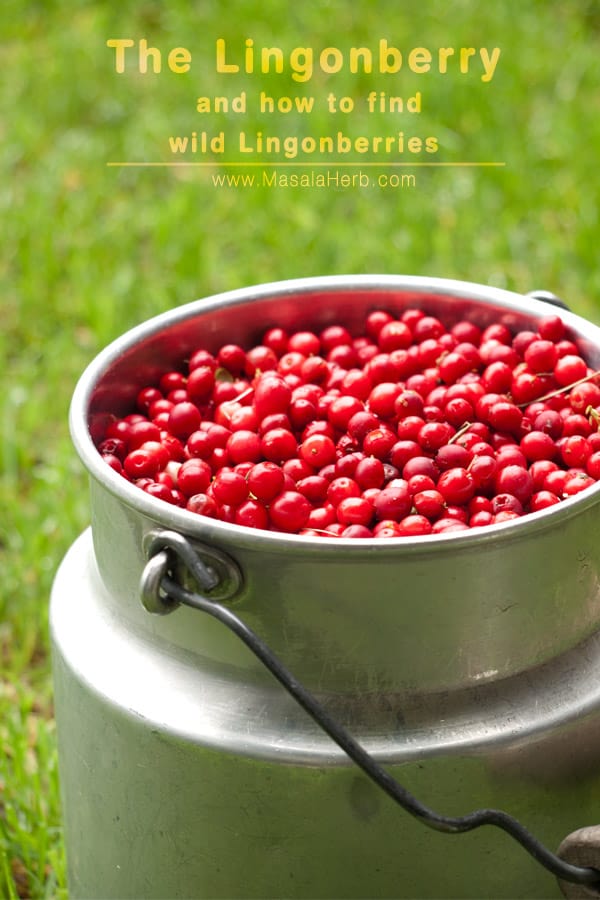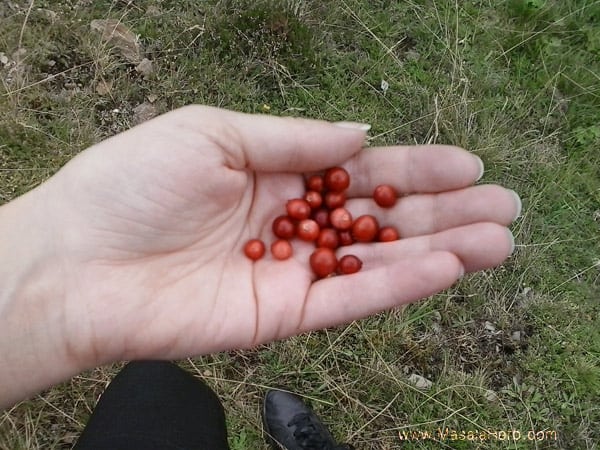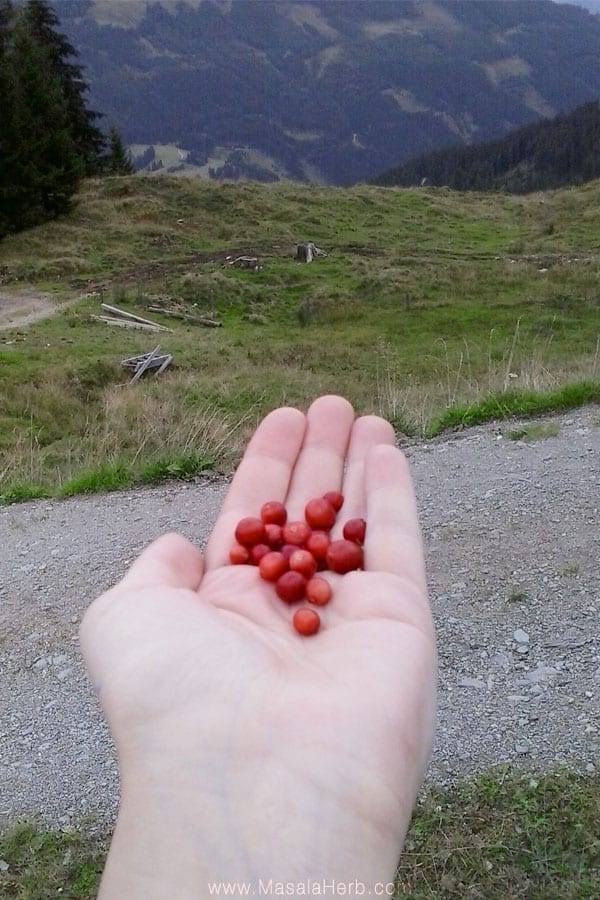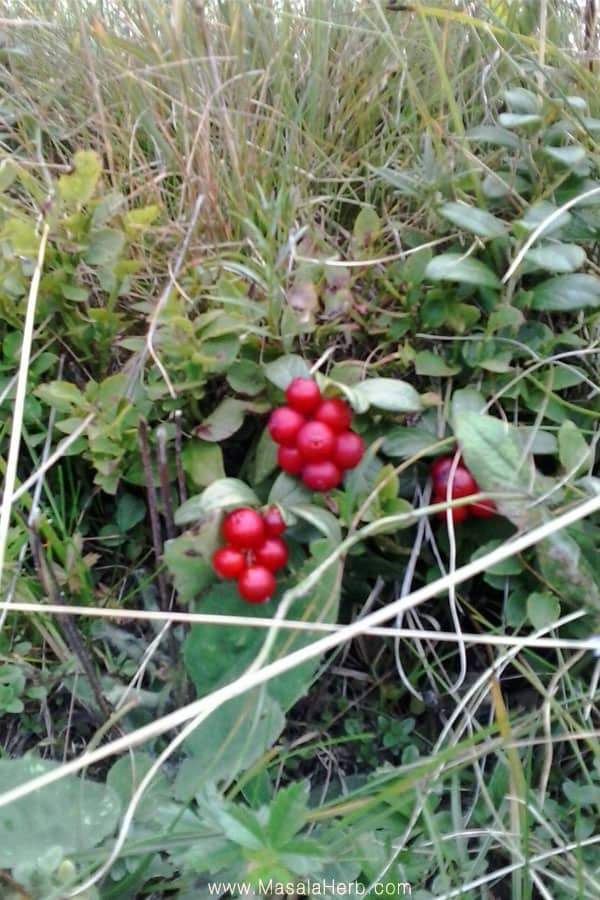For a very long time I have been pondering how I should call these majestic rarer European mountain berries.
In the end, I decided to leave it at Lingonberry.


Global Food Recipes
with Spices and Herbs
Free E-Book available for a limited time. Grab yours now and get instantly inspired!
You missed out!
You might ask yourself why?
Well, I will just let you take a look at the picture below and most probably you will come to a common conclusion.
Especially, if you are from the US or Canada, you might recognize and understand what I am trying to convey here.
Jump to:
Does the berry not remind you of something?
Maybe you will have the picture of Thanksgiving cranberry sauce in your mind?
Well, the lingonberry is kind of related to the popular Cranberry and that is why I was having trouble to name the berry properly.
Apparently I am not the only one getting confused by the english berry name.
Is Lingonberry and Cranberry the same?
In German the Lingonberry is known as Preiselbeere and in french airelle rouge, which is pretty clear and no confusion arises in those languages.
Coincidentally, when we collected Lingonberries in the Austrian alps, we came across a quaint and quiet restaurant, which was serving Austrian specialties such as Schnitzel.
Now, if you remember the Schnitzel recipe, Austrians always enjoy their Schnitzel with Lingonberry Jam.
It's a fashion, it's a marriage of meat and sour/sweet berry flavors and a must in our culture!
So, when I was going through my husband's English menu card I noticed the translation saying “Schnitzel served with cranberry sauce”.
This five-star restaurant is not the only one having doubts about the name of this mountain berry.
Is it a cranberry, or is it not?
One thing is sure, it's not a blueberry, although lingonberries are related to blueberries, and occasionally, they grow side by side.
I personally decided to keep it this way: Cranberries are American and Lingonberries are European.
Cranberries grow in water and are mostly farmed these days, Lingonberries, on the other hand, grow in higher altitudes such as in the alps.
Lingonberries are smaller but both, lingon- and cranberry are similar in texture and flavor.

Others in the World Wide Web have been apparently facing the same name giving conundrum.
Have a look at the post “Cranberry vs. Lingonberry” from Timeless Environments and “Lingonberry” at wikipedia.
We hunted down Lingonberries, and we collected about 4 kg of wild Lingonberries that August day.
Even locals in the alps don't always know where they can find wild Lingonberries.
Some of our family members even travel by car first for an hour and then walk through the forests for hours just to find a few red and ripe lingonberries.
Sounds crazy doesn't?
Why is Lingonberry so expensive?
Well, I think Lingonberries are some of the most expensive local alpine fruits in the market, and I will summarize why:
- Lingonberries grow only in higher altitudes at around ~1000 m above the sea level
- If you find a few Lingonberries, it doesn't mean you will automatically find more around. That means, these berries are limited and rare.
- Only certain places in the mountains, which are kept secret by locals, are suited for the growth of Lingonberries.
- Lingonberries can only be harvested from end of August to mid September
- The berries grow frequently under thick moss, so you need to carefully look in between the moss to find a few lingonberry jewels. That means they are not directly visible to us, although they are very red in color. Be aware of frogs and slimy naked snails when digging around in the warm moss environment! =P
- The berries need to be cooked first before they can be eaten. They are not tasty raw.
- It can take about 2 hours if 2 people search for wild lingonberries and the result will be 1 kg. Lot of work = small amount of berries.
- Lingonberry Jam is so popular in Austria (and other northern countries in europe) that the prices for a jar of jam has been pushing up.
- Homemade Lingonberry jam is even more expensive because of the huge flavor difference. Homemade lingonberry jam has a unique natural flavor which is hard to explain. It's more natural, it's more intense and it will remind you of warm summer days in the alps. To get a hand on real lingonberry jam is not easy and the price varies from 5,50 € to 10 € per small jar.

Where to find Lingonberries?
What if you have found a secret corner in the mountains where locals promised you to come across Lingonberries?
How do you spot Lingonberries?
We mostly found Lingonberries in the Alm.
An Alm is a place where the farmers keep their cows to feed during 2-3 months in the summer in Austria.
Alms are always high up above the sea level and these are green mountain slopes and high altitude valleys.
Coincidentally another name for the Lingonberry is Cowberry
According to me that's because Lingonberries grow on those hills where the cows feed during august time.
So, we found on the steep grass slopes little moss collections with some purple looking flower shrubs growing in between.
And, low and behold between the moss and purple flower combination a few red berries popping out.
At first not visible to the eye, we ended up finding all our Lingonberries by “digging” and looking deep into the moss patches.
This means that you will have more chances finding the Lingonberries in the Alms.
A Lingonberry first grows white and slowly turns from white to pink to a full red shade.
The berry itself is always hard, round to oval shape, and it's heavier compared to blueberries.
The plant is grows very low and has a roundish leaf shape.
Similar to blueberry shrub leafs, except that the Lingonberry leafs are harder and tougher.

What all can you make with Lingonberries?
Lingonberry Jam is a popular breakfast addition.
A special well-known Tyrolean fried yeast “bun” known as Germkirchl can be served either sweet with Lingonberry Jam or savory with Sauerkraut.
You can also make lingonberry flavored water!
In Austria, they even turn the berry into a popular Schnapps.
We were served a regular pear schnapps with preserved lingonberries.
My aunt recently mentioned that somebody was making a lingonberry syrup.
Next time I am in Austria during August or September, I will be checking out the recipe for lingonberry syrup.
The pharmaceutical industry in Europe has been producing Lingonberry powders and chewable toffees.
These are a great option when treating bladder and kidney infections.
I swear on lingonberry medicine for this purpose, since I have always had bladder problems.


These remind me of the wintergreen berries I used to find in our sheep/goat pasture. I never found many at one time, there weren't a lot of plants but it was the only place I could find them. (Wintergreen leaves steeped in whisky make for a great natural wintergreen flavoring by the way. Just stuff a bottle with the leaves, finish filling it with whisky, cork and store for a month before use,) It's too bad lingonberries don't grow in North America or that they can't be farmed, I'd love to work with them. I've worked so many wild berries, including alpine strawberries, blackberries, dewberries (a local golden colored wild raspberry), wild grapes and many others, including wild currents.
I can relate, I wish I could get a hand on your North American berry variations. I don't know wintergreen berries and some of the others that you mentioned, but I hope to discover them on a possible future trip to Northern America. 🙂
Same in Norway! Lingonberry (Norwegian: tyttebær) bushes, along with blueberry bushes, are the main type of forest-ground cover throughout the entire country. You can easily get a few kilos per hour at this time of year here if you find a particularly dense patch, which is not that hard to do.
Thanks for the informative blog! 🙂
Thanks for sharing Alex. Yeah I'm not that fast in collecting lingonberries, but my husband Paul is more efficient. 😀
Interesting blog post!
I am Swedish and the name "lingonberry" actually comes from the Swedish name for the berries which is "lingon". Lingonberries have traditionally been an accompaniment to pretty much 99 % of traditional Swedish dishes, especially meaty, heavy dishes. However, I had no idea that it is a traditional accompaniment to Austrian dishes, even including the famous schnitzel. Heck, I didn't even know it grew in the Alps. In the olden days, when sugar was hard to come by, people used to just lightly "mash" or stir the berries without adding any sugar. Because of the natural preservant in the berries it actually lasts for months like that if they are stored in a cold place, like the fridge or a root cellar. I actually do this myself too - it makes for a more interesting and savory accompaniment than sugary sweet lingonberry jam, in my opinion. You should try it! I was also fascinated to hear about the lingon schnapps with lingonberries. In Sweden we have a traditional desert called "lingonpäron" (literally "lingon pears") which are boiled pears conserved in a light lingonberry syrup. It's a great combination.
Oh cool lingonberries with pears. I love the idea of food combination. It's always nice to share some knowledge.It's funny that u mention that you store your berries in a cool place because that's what I just tried to do and the berries have been in the attic (it's about 3 Celsius these days) for the past 2 months and they still look fresh. I actually tried to dry the berries to turn them into a red powder for ailments. Looks like I will need to dry them in the oven. So how do you use them further in your food?
I live in Finland and lingonberries are the most common berries to find in our forests, they don't even require high altitudes here because of our mild climate. They are the cheapest berries to buy because of how plentifully they grow. We make it into jam to use as a condiment to savory dishes but it can also be used in cakes. I had no idea they grew in Austria, I found this article very interesting!
Hi Fia,
I have heard that lingonberries are common in your lands but I had no idea that they were that plentiful. You guys are so lucky!
Happy to read that you enjoyed this post. =)
You are right, these are not cranberries (I have also seen them on menus as cranberries). I remember I used to pick them in the forest too... They are so delicious with savoury dishes, aren't they? They have this nice slight bitterness...
Wow, what a wonderful find while foraging, Helene! I have had lingonberry cordial and jam, I think. Love this!
I've heard of lingonberries but only from you. 🙂 I can't believe you found so many of them. They aren't easy to find that low to the ground. What fun to get to pick so many of them and then make the jam.
I have seen these only before, can you imagine how delicious they would be in a pie? 😀
Cheers
Choc Chip Uru
these berries sound so cool and love the vibrant color of them.
There are similar looking berries found in India also, the hawkers sell those. I am sure, those are not these. But, still wanted to ask: have you seen anything similr in Goa?
They kind of look like wild berries that grow around here. Though I have seen the actual berries but I am sure I have read this name on jam bottles.
They kind of look like wild berries that grow around where I live. I have never actually seen the lingon berries, though I am sure I have seen the jam in farmer's market.
I had never heard of these berries before. They look like like little rubies. Thank you Helene for letting us know about a berry that was unheard of 🙂
It quite obvious that you are as much of a berry lover as I am. Wish I could find these gorgeous little lingonberries. Interesting post!
Those berries look so cute. I have never seen them, though have heard of them, possibly read about them at a blog.
Such an interesting post! I never knew much about lingonberries as we don't really get fresh ones here, only jams but they're big in Scandi cooking 🙂
Are lingonberries same as Preisebeeren?
I still dare not to pick wild berries as I am always worried there are bugs in them.
Yes lingonberries are preiselbeeren in german. Those don't have insects/worms in them. Rasberries are always full of insect because of the space in the berries, other berries are not affected by insects. You are missing out Angie. 😉
I have heard of Lingonberries and believe I've seen them before but never realized what they were. Great information. Now everytime I'm out among in the fields I'll be looking for them. Very informative post. I always like to learn something new. Have a great day!
Quite informative,good to know about a totally unheard new fruit variety and awesome snaps too
I've never seem lingonberries here in the mountains... Will have to look better next time!
Cheers,
Rosa